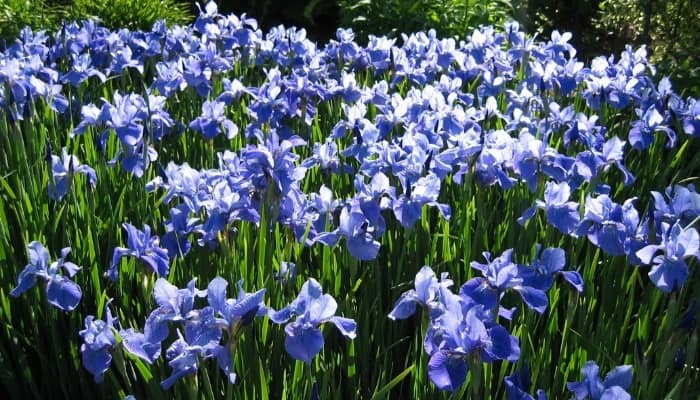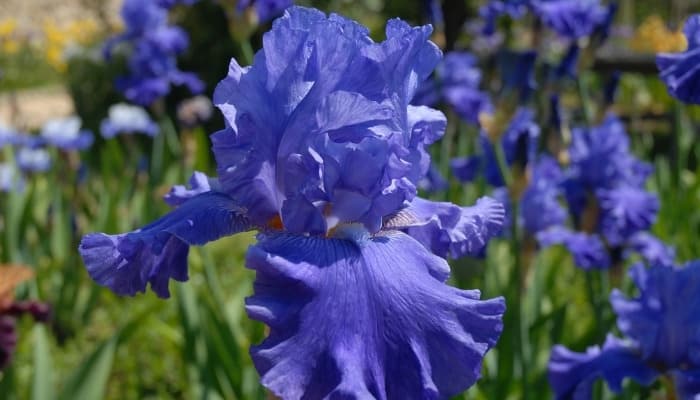Iris plants, similar to other blooming flora, require fertilizers with high levels of phosphorus and low levels of nitrogen.
Some plants need a complex regimen of fertilizing where you start them off with nitrogen-high fertilizers and then switch to a phosphorus-high variety around bloom time, but fertilizing irises is straightforward and easy, especially when you use bone meal.
Is bone meal good for irises? Bone meal is an ideal fertilizer for irises. It has a low content of nitrogen and high phosphorus concentrations to encourage blooms while keeping leaves and stems at the bare minimum. You’ll need to apply it in the early spring and then apply it again after the last flower has faded.
Unlike many organic fertilizers, bone meal should be added in limited amounts to the soil. In the following, you’ll find out how to properly use bone meal to fertilize irises.
Bone Meal for Irises
Although irises are not heavy feeders, they don’t do well in poor soil.
Organic fertilizers such as bone meal are ideal for irises since they don’t stress the plants with sudden growth spurts and the low nitrogen content doesn’t impact the flowering.
What Does Bone Meal Do for Plants?
The main reason gardeners add bone meal to the soil is to increase phosphorus for flowering plants and vegetables.
Phosphorus is essential for the development of the root system of the plants, which in turn helps them fight off diseases and infections.
A healthy root ball allows the plant to grow its leaves and stems much faster.
Vegetables, fruits, and flowering plants all need phosphorus in bone meal to develop flowers in abundance. Low phosphorus can lead to diseases such as blossom end rot.
How Irises Benefit From Bone Meal
As flowering plants, irises benefit a lot from bone meal.
The calcium in the bone meal is essential for building the walls of the cells, which helps the irises build strong stems that can weather the occasional drought and temperature fluctuations.
Providing irises with bone meal increases the blooms you get out of them. The flowers grow larger with brighter and richer colors thanks to the added dose of phosphorus.
This nutrient also gives the irises a longer bloom season and might increase the vase life of the flowers.
Is Bone Meal a Complete Fertilizer for Irises?
Bone meal is far from being a complete fertilizer for any plant including irises. Although high in phosphorus, bone meal has low amounts of nitrogen and zero potassium content.
While irises are happy with the low nitrogen ratio in bone meal, they still need potassium to grow and thrive.
If the soil is poor or depleted, then the small nitrogen content in bone meal is hardly enough for the growing irises.
It is recommended that you use a balanced fertilizer (Espoma Organic Bulb-tone is excellent) to provide the irises with the nitrogen and potassium they need to develop healthy stems and leaves.

When To Apply Bone Meal to Irises
The best time to apply bone meal is in the early spring before the first buds have emerged.
Bone meal is a slow-release organic fertilizer, and it takes time for the nutrients to break down and become available for the roots.
Once the blooms are open, apply bone meal again around 4 weeks after the first flowers. This second and last application should be enough to feed the plants until the end of the bloom season.
How To Use Bone Meal for Irises
Unlike compost and other organic fertilizers, bone meal should be used cautiously with irises.
Too much bone meal in the soil can attract bugs and rodents to the garden. If you add too little, the irises won’t get the intended benefits.
Here’s how to use bone meal for irises in easy 7 steps.
- The first application of bone meal should be in the early spring before the first buds.
- Check the soil pH, and make sure it’s slightly acidic between 5.5 and 6.5 to help the roots absorb phosphorus.
- Fill half a cup with bone meal for each iris in the garden.
- Spread the bone meal evenly in a circle 3 inches away from the base of the plant.
- Break any bone meal lumps in the soil that would attract pests.
- Work the bone meal into the soil with a rake, making sure to mix it with the top 2 inches of the soil.
- Water the soil thoroughly to push the bone meal deeper into the soil and closer to the iris roots.
Guide To Fertilizing Irises
While irises are not fussy in general, the perennial plants tend to deplete the soil over time.
To ensure that they keep blooming year after year, you’ll need to fertilize them using bone meal in combination with another balanced fertilizer.
A strong fertilizer can have an adverse impact on the flowers, especially if you use it at full strength.
Nitrogen triggers the growth of leaves and stems at the cost of flowers. To avoid that, I recommend using organic fertilizers such as seaweed extracts or fish emulsions.
Homemade compost is also an ideal fertilizer to use along with bone meal for irises.
Irises need only two applications of bone meal per year. The first is in the late winter or early spring once the soil becomes workable. The second application is about 4 weeks after the first blooms.
For the balanced fertilizer, apply it once every 4 to 6 weeks throughout the growing season.
Related Questions:
Can Bone Meal Burn Plants?
Bone meal is a slow-release organic fertilizer. The nutrients in bone meal are not readily available for the roots and take time to break down. That means they will not cause root burn in plants.
Is Bone Meal Good for all Plants?
Bone meal is only good for plants that thrive in slightly acidic soil. That’s when the roots can absorb the phosphorus in bone meal.
Final Thoughts
Irises benefit from the phosphorus and calcium in bone meal. Apply the organic fertilizer in the early spring and then once more 4 weeks after flowering.

